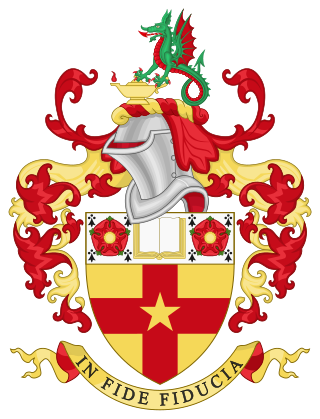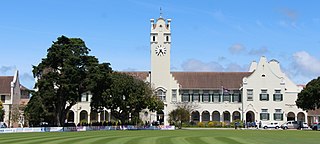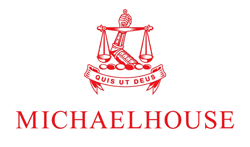
Kearsney College is a private boarding, English medium high school for boys in Botha's Hill, a small town between the provincial capital of Pietermaritzburg and Durban, in the KwaZulu-Natal province of South Africa.

The Leys School is a co-educational private school in Cambridge, England. It is a boarding and day school for about 574 pupils between the ages of eleven and eighteen, and the head is a member of the Headmasters' and Headmistresses' Conference.

The Diocesan College is a private, English medium, boarding and day high school for boys situated in the suburb of Rondebosch in Cape Town in the Western Cape province of South Africa. The school was established on 2 October 1849 by the Anglican Bishop of Cape Town.

St John's College is a private Anglican day and boarding school situated in Houghton Estate in the city of Johannesburg in the Gauteng province of South Africa. It was founded in 1898 and comprises five schools: College, Preparatory, Pre-Preparatory and The Bridge Nursery, as well as a co-educational Sixth Form. St John's College is a member of the ISASA.

Pretoria Boys High School is a public, tuition-charging, English-medium high school for boys situated in the suburb of Brooklyn in Pretoria in the Gauteng province of South Africa, founded in 1901 by Alfred Milner, 1st Viscount Milner.
Maritzburg College is a semi-private English-medium high school for boys situated in the city of Pietermaritzburg, in KwaZulu-Natal, South Africa. It was founded in 1863 and it's the oldest boys' high school in KwaZulu-Natal – and one of the oldest schools in South Africa. As of February 2024 it is attended by 1 260 students, of whom approximately 495 are boarders.
St Stithians College is a private Methodist school situated in the suburb of Lyme Park in the border of Sandton and Randburg in the Gauteng province of South Africa. Founded in 1953 by Albert Collins, William Mountstephens and Gilbert Tucker, it has consistently ranked amongst the top performing independent schools in South Africa. It follows a co-ordinate educational model within a village of schools consisting of boys' and girls' colleges, boys' and girls' preparatory schools, and a junior preparatory. It is built on a 100 hectare estate, one of the largest school campuses in the country.

Aitchison College is an independent, semi-private boys school for boarding and day students from grade 1–13 in Lahore, Pakistan. It has a tradition of providing an education that uses academics, sports, and co-curricular activities as tools for character development. The school follows a curriculum designed to culminate in the International General Certificate of Education and AS Level/A Level qualifications and is geared towards preparing students for university education. The institute is the only Pakistani school that is a member of the G30 Schools of the World. Aitchison has educated former Prime Ministers, including Imran Khan, and former President Farooq Leghari, lawyers, cricketers, and politicians.
St. Andrew's School, established in 1863 is a public school for boys located in Bloemfontein, Free State, South Africa.
St Charles College, founded in 1875, is a Christian, independent boys college situated in Pietermaritzburg, South Africa, catering for day boys from Grade 000 to Matric, with boarders from Grade 4 upwards.

St. Alban's College is a private, boarding, English medium and day high school for boys situated in the suburb of Lynnwood Glen in Pretoria in the Gauteng province of South Africa. It was founded in 1963 by Anton Murray. Its history, influence, wealth, and academic reputation have made it one of the most prestigious schools in South Africa. The sister school is called St. Mary's Diocesan School for Girls, Pretoria.

Wynberg Boys' High School is a public English medium boys high school situated in the suburb of Wynberg of Cape Town in the Western Cape province of South Africa. Founded in 1841, it is one of the best academic schools in Cape Town, it is believed by scholars and old boys to be the second oldest school in South Africa, however, there are several schools that were established at earlier dates as far back as 1738.

Grey High School is a semi-private English-medium high school for boys situated in the suburb of Mill Park in Gqeberha in the Eastern Cape province of South Africa. It is one of the top sporting schools in the country, with consistently strong academics and an extensive culture of musical performance, and is one of the oldest schools in South Africa.
Churchill School is a public, day and boarding school for boys aged 12 to 19 located in the Eastlea suburb of Harare, Zimbabwe. The school had the first school pipe band in Zimbabwe and produces cricket players of national and international calibre.

Queen's College Boys' High School, more commonly referred to as Queen's College, is a fee-paying public school for boys situated in the town of Queenstown, Eastern Cape. Established in 1858 first as Prospect House Academy, it is the oldest school in the Border region and among the 100 oldest schools in South Africa. The college is associated with Queen's College Boys' Primary School, which was established on 15 November 1957, a year before the high school marked 100 years of existence.
Clarendon High School for Girls is a public English medium high school for girls situated in the suburb of Selborne of East London in the Eastern Cape province of South Africa. It was founded in 1903 as East London Girls' High School, The brother school is Selborne College, It is one of the oldest school for girls in South Africa.

Parktown Boys' High School is a public English medium high school for boys situated in Parktown, a suburb of Johannesburg in the Gauteng province of South Africa. It is one of the oldest schools in Johannesburg. Parktown Boys' sister school is Parktown High School for Girls.

Fairbairn College is a public, co-educational high school in Goodwood near Cape Town, Western Cape, South Africa.

Michaelhouse is a full boarding senior school for boys founded in 1896. It is located in the Balgowan valley in the Midlands of KwaZulu-Natal, South Africa.

St. John's Preparatory School is an independent, preparatory day school for boys aged 5 to 12 in Borrowdale, Harare, Zimbabwe. The school is owned and governed by the St. John's Educational Trust, as is St. John's College.















